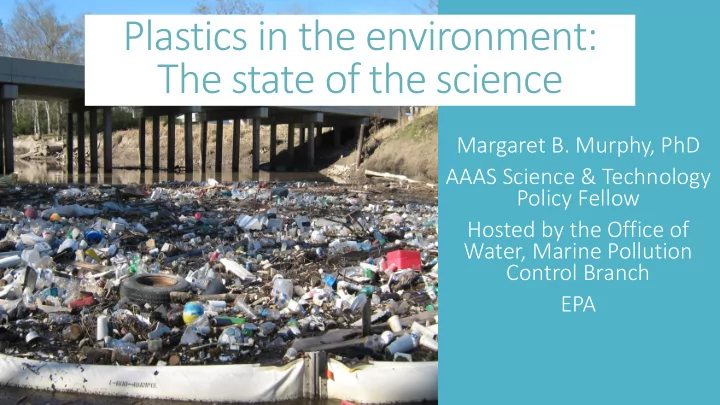

Plastics in the environment: The state of the science Margaret B. Murphy, PhD AAAS Science & Technology Policy Fellow Hosted by the Office of Water, Marine Pollution Control Branch EPA
What’s the problem? What are the impacts? Macro- and micro- Human and ecological health What are the uncertainties? What do we need to know?
What’s the problem?
http://www.relatably.com/q/img/just-one-word-plastics-quote/plastics.png
A brief timeline… Yea ear Material 1868 Cellulose Nitrate 1907 Phenol-Formaldehyde (Bakelite) 1927 Cellulose Acetate (Rayon) 1929 Urea Formaldehyde 1931 Polystyrene 1933 Polyvinyl Chloride 1935 Ethyl Cellulose 1936 Acrylic, Polyvinyl Acetate 1938 Nylon 1941 Polyethylene Terephthalate (PET) 1942 Polyester 1943 Silicone 1947 Epoxy http://www.modip.ac.u k/resources/curators_ 1954 Polypropylene guide/plastics_timeline
A brief timeline… Yea ear Material 1868 Cellulose Nitrate 1907 Phenol-Formaldehyde (Bakelite) 1927 Cellulose Acetate (Rayon) 1929 Urea Formaldehyde 1931 Polystyrene 1933 Polyvinyl Chloride Plas lastic ics are wide idely ly avail ilable le, use seful, l, durable le and cheap 1935 Ethyl Cellulose 1936 Acrylic, Polyvinyl Acetate 1938 Nylon 1941 Polyethylene Terephthalate (PET) 1942 Polyester 1943 Silicone 1947 Epoxy http://www.modip.ac.u k/resources/curators_ 1954 Polypropylene guide/plastics_timeline
Plastics in the environment NOAA
Plastics in the environment NOAA Majo jorit ity of f pla lastic ics in in th the envi vironment are fr from lan land-based so sources Local l and glo lobal l proble lem
Aquatic Trash — Plastic Jam Jambeck et al al. . 2015 2015
Microplastics Plastic fragments, beads and fibers less than 5 mm in size Primary microplastics: Commercially produced microplastics E.g. microbeads, plastic nurdles Secondary microplastics: Formed by the breakdown of larger plastic items Syberg et al al. 2015 2015
Microplastics Erik Eriksen et t al al. 2015
Research in the US — Great Lakes Mason et al. 2016 Driedger et al. 2015
Great Lakes microplastics Erik Erikse sen et al al. . 2013 2013
Gulf of Mexico estuary — Alabama Wessel et al., 2016
What are the impacts?
NOAA NOAA NOAA
Ite Item Ra Rank of of Ex Expected Imp Impact Mea ean Bird Bi Turtle Mammal Wilcox et al. Buoys/traps/pots 1 1 1 1 2016 Monofilament 2.3 3 2 2 Fishing nets 2.7 2 3 3 Plastic bags 5.7 4 9 4 Plastic utensils 5.7 7 4 6 Balloons 6.7 8 5 7 Cigarette butts 7.3 5 12 5 Caps 7.7 9 6 8 Food packaging 8.7 10 7 9 Risk of Ri of im impact Other EPS packaging 9.7 11 8 10 Hard plastic containers 11.3 6 13 15 Plastic food lids 11.3 13 10 11 Straws/Stirrers 12.3 14 11 12 Takeout containers 15.3 15 18 13 Cans 15.7 17 14 16 Beverage bottles 16 12 17 19 Unidentified plastic fragment 16.3 16 19 14 Cups & plates 16.7 18 15 17 Glass bottles 17.7 19 16 18 Paper bags 20 20 20 20
Plastics impacts: Macro-scale Entanglement & ingestion Entanglement: energetic costs, reduced feeding, impaired behavior, injury, death Ingestion: energetic costs, digestive injury/blockage, nutritional costs, death Transport of invasive species (biofilms, pathogens?) Habitat damage, vessel damage/navigation hazards, tourism costs
Plastics impacts: Micro-scale Ingestion Energetic costs, digestive injury/blockage, nutritional costs, death Exposure to chemicals in plastics (e.g. flame retardants [PBDEs, etc.]) and sorbed onto plastics (e.g. PCBs, DDTs, etc.) Transport of invasive species Biofilms, pathogens?
Microplastics effects studies: Overview Microplastics have been studied in various species groups, with more studies being published every day Focus on invertebrates and fishes Birds and mammals are more studied for macroplastic impacts than microplastic impacts
Rochman et al. 2016: “The ecological impacts of marine debris: unravelling the demonstrated evidence from what is perceived” Si Size of of pla plasti tic Bi Biolo logical Co Complexit ity Number of studie ies
Rochman et al. 2016: “The ecological impacts of marine debris: unravelling the demonstrated evidence from what is perceived”
What are the uncertainties?
Methodology Wagn agner et t al al. 2014 No standardized sampling methods No standardized methods for extraction, quantification and Quantification characterization of microplastics Characterization? from any sample type No standardized reporting methods
GE GESAMP 2015 2015 Impacts across scales Macroplastics, microplastics, nanoplastics … Individuals, populations, species, communities, ecosystems
Human health impacts Microplastics reported at low levels in seafood (especially shellfish), sea salt Chemical exposure? Impacts on human health are not known Impacts on subsistence communities in the US and globally? Mosquito-borne diseases
What do we need to know?
1. Establish metrics and processes for data collection and analysis for microplastics 2. Understand the sources, frequency, fate and transport of plastics 3. Assess potential human health risks from microplastics 4. Evaluate ecosystem impacts of plastics at individual and population levels
Wrig ight et al al. . 2013 2013
Thank you! Murphy.Margaret@epa.gov
Recommend
More recommend